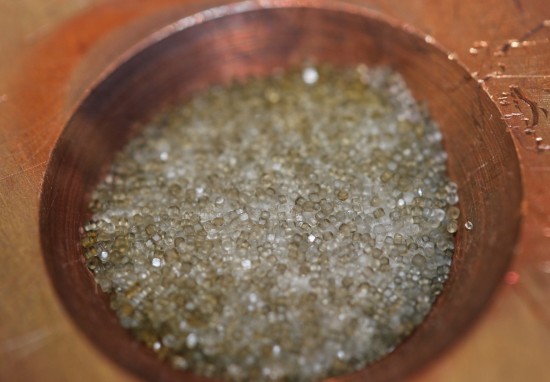
Excerpt earthsky.org
Laboratory experiments have lead to new information about the
chemical composition of the mysterious dark material in the long, dark
fractures on the surface of Europa, a large moon of Jupiter. Researchers
at NASA’s Jet Propulsion Laboratory (JPL) mimicked conditions on
Europa’s surface. They now say that the dark material is discolored
salt, likely sea salt from below the moon’s icy crust. The journal
Geological Research Letters published their study on May 15, 2015.
The scientists say this new insight is important in considering
whether this icy moon might be hospitable for extraterrestrial life.
The life question is a key one for Europa, since this world is believed
to have a liquid ocean beneath its crust. The presence of sea salt on
Europa’s surface suggests the ocean is interacting with its rocky
seafloor.
Scientists have been intensely curious about Europa since Galileo
discovered it in 1610. In recent years, they’ve puzzled over the dark
material coating the long, linear fractures on Europa’s observable
surface. The material was associated with young terrain on this moon of
Jupiter, suggesting that it had erupted from within Europa.
However, the chemical composition of the dark material remained elusive, until now.
Planetary scientist Kevin Hand at JPL led the new study. He said in a statement:
If it’s just salt from the ocean below, that would be a simple and elegant solution for what the dark, mysterious material is.
Europa is immersed radiation from Jupiter’s powerful magnetic field,
causing high-powered electrons to slam into the moon’s surface. Hand
and his team created a laboratory test that mimicked the conditions of
Europa’s temperature, pressure, and radiation exposure. They tested a
variety of samples including common salt – sodium chloride – and salt
water in a vacuum chamber at Europa’s chilly surface temperature of
minus 280 degrees Fahrenheit (minus 173 Celsius). They also bombarded
the samples with an electron beam to imitate Jupiter’s influence.
After several hours – a time period corresponding to over a century
on Europa, the researchers said – the salt samples were observed to go
from white to a yellowish brown, the color similar to the features on
the icy moon. Hand said:
This work tells us the chemical signature of
radiation-baked sodium chloride is a compelling match to spacecraft data
for Europa’s mystery material.

Until now, telescopic observations have only shown glimpses of
irradiated salts. No telescope on Earth can observe Europa’s surface
with enough resolution to identify them with certainty. Researchers
suggest additional spacecraft observation to gather more evidence.
A visit to this icy world would help answer the most tantalizing
questions about Europa. Long believed to have a liquid ocean of salt
water below its icy surface, this moon continues to display promising
conditions for extraterrestrial life.
As Europa orbits Jupiter, it experiences strong tidal forces similar
to Earth and the Moon. These forces from Jupiter and the other Jovian
moons cause Europa to flex and stretch, which creates heat, and results
in Europa having a warm internal temperature than it would with just the
heat from the Sun alone.
Recent observable geological activity also creates strong evidence
that the subsurface ocean interacts directly with Europa’s rocky
interior, making geothermal vents, like those in Earth’s oceans, a
strong possibility as well.
These hydrothermal vent ecosystems on Earth thrive with no energy
from the sun. Bacteria, shrimp and crustaceans have all been observed
in these extreme environments, surviving on what researchers have deemed
chemosythesis.
With Europa’s enormous amount of liquid salt water, essential
chemical elements and geological activity, this long discovered icy moon
appears to be one of the solar systems most promising locations for
habitable requirements for life.
However, until a devoted spacecraft visit’s, nothing beyond hopeful speculation can be proven, the researchers say.
Bottom line: Researchers at NASA’s Jet Propulsion Laboratory created
laboratory conditions that mimicked those on Jupiter’s large moon
Europa, to learn the chemical compositions of the material in long, dark
fractures in the moon’s surface. They now believe this material is sea
salt, which has emerged to Europa’s surface from its liquid ocean
below.
Source Article from http://feedproxy.google.com/~r/AscensionEarth2012/~3/VQUbX_E0Gsg/sea-salt-discovered-on-jupiters-moon.html
 RSS Feed
RSS Feed















 May 18th, 2015
May 18th, 2015  FAKE NEWS for the Zionist agenda
FAKE NEWS for the Zionist agenda 
 Posted in
Posted in 













